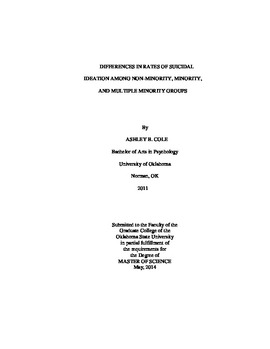| dc.contributor.advisor | Wingate, LaRicka R. | |
| dc.contributor.author | Cole, Ashley B. | |
| dc.date.accessioned | 2015-06-17T20:05:19Z | |
| dc.date.available | 2015-06-17T20:05:19Z | |
| dc.date.issued | 2014-05-01 | |
| dc.identifier.uri | https://hdl.handle.net/11244/14775 | |
| dc.description.abstract | Theories from the social psychology literature have posited that members of cultural groups are exposed to more frequent and damaging stressors, such as prejudice, discrimination, and oppression. Additional research has examined this concept in the context of individuals who belong to multiple minority groups, proposing that effects may cumulate for these individuals, thus they may experience additional psychological distress beyond that experienced by members of a single minority group. In the suicidology literature, research has found that members of minority groups have differential rates of suicide. Extrapolating these findings, the aim of the current study was to compare rates of suicidal ideation broadly across three groups: non-minority, single-minority, and multiple minority groups in order to identify populations who are at a higher risk for suicide. For the purposes of this study, individuals were classified as a minority through several distinct characteristics through which they self-identified, including ethnicity, sex, and sexual orientation. Specifically, it was hypothesized that the multiple-minority group would have the significantly highest level of suicidal ideation compared to the single-minority and non-minority groups. Next, the single-minority group was expected to have significantly higher levels of suicidal ideation compared to the non-minority group. Furthermore, the two minority groups were hypothesized to experience significantly higher rates of suicidal ideation overall compared to the non-minority group. An omnibus, one-way ANOVA was used to analyze study findings. Results of the overall ANOVA model were non-significant; however, based on a priori hypotheses and an examination of the means plot of group differences in expected directions, exploratory non-orthogonal (planned comparisons) were conducted. Results of the planned comparisons indicated there was a significant difference between the non-minority group and both the single and multiple minority groups when compared simultaneously. This result suggests that simply belonging to a minority group increases one's risk for suicidal thinking. | |
| dc.format | application/pdf | |
| dc.language | en_US | |
| dc.publisher | Oklahoma State University | |
| dc.rights | Copyright is held by the author who has granted the Oklahoma State University Library the non-exclusive right to share this material in its institutional repository. Contact Digital Library Services at lib-dls@okstate.edu or 405-744-9161 for the permission policy on the use, reproduction or distribution of this material. | |
| dc.title | Differences in Rates of Suicidal Ideation among Non-minority, Minority, and Multiple Minority Groups | |
| dc.type | text | |
| dc.contributor.committeeMember | Grant, DeMond | |
| dc.contributor.committeeMember | Chaney, John | |
| osu.filename | Cole_okstate_0664M_13406.pdf | |
| osu.accesstype | Open Access | |
| dc.description.department | Psychology | |
| dc.type.genre | Thesis | |
| dc.subject.keywords | minority | |
| dc.subject.keywords | suicide | |

